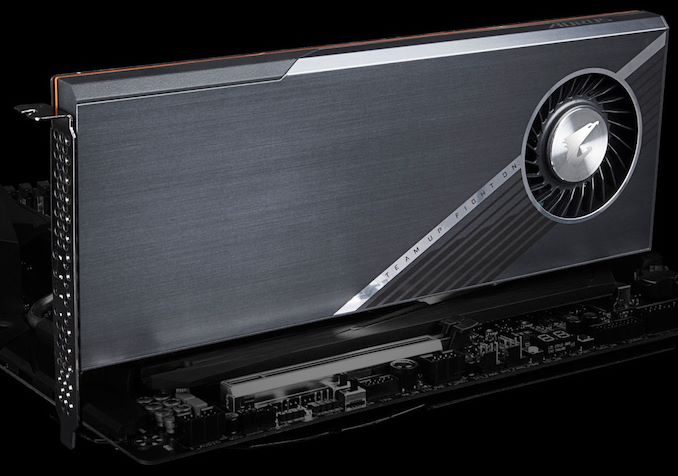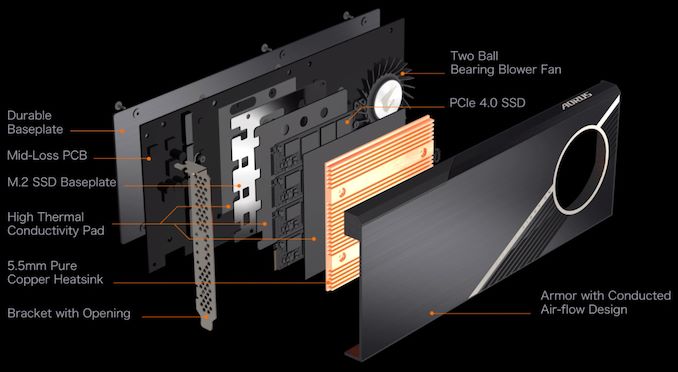GIGABYTE’s Aorus Gen4 AIC SSD 8 TB Launched: Up to 15 GB/s
by Anton Shilov on September 19, 2019 6:30 PM EST
After originally showcasing it at Computex a bit earlier this year, GIGABYTE has officially introduced its quad-SSD PCIe 4.0 adapter card, the AORUS Gen4 AIC. Designed house up to 4 NVMe SSDs, the card is essentially a multi-way M.2 adapter, allowing a PCIe 4.0 x16 slot to be used to drive four x4 SSDs. Fittingly, with so many high-end SSDs on a single board, the card also features an active cooling system to ensure that the drives run at consistent speeds even under high loads. Fully populated with PCIe 4.0 SSDs, the card is rated to provide up to a staggering 15 GB/s of throughput – at least, if you can come up with a workload that can saturate such a setup.
GIGABYTE’s Aorus Gen4 AIC SSD 8 TB is a PCIe 4.0 x16 board with eight PCIe Gen 4 re-drivers. The card in turn carries four 2 TB M.2-2280 SSDs based on Phison’s PS5016-E16 controller, which remains the only client SSD controller with a PCIe 4.0 x4 interface. The card also features a sophisticated cooling system comprising of a large copper heatsink, a 5-cm ball bearing fan, and a baseplate, along with eight thermal sensors to monitor everything. That monitoring, in turn, is provided by the Aorus Storage Manager software, which can also configure the cooling on the card and supports three fan operating modes, including Silent, Balanced, and Performance.
When running in RAID 0 mode, the Aorus Gen4 AIC SSD 8 TB offers up to 15 GB/s sequential read/write speeds, as well as 430K/440K read/write IOPS. It goes without saying that this is a throughput-focused card, as outside of the difficulty in even coming up with that many IOPS in a client workload, RAID modes don't really improve IOPS.
While the sequential performance of the Aorus Gen4 AIC SSD 8 TB looks extremely attractive, there is a caveat. The only enthusiast-class PCIe Gen 4-supporting platform today is AMD’s Ryzen 3000, and these CPUs only support 24 PCIe 4.0 lanes: x16 for an add-in-card, x4 for an NVMe SSD, and x4 to connect to the chipset. As a result, to make full use of the card you have to give up a board's sole PCIe 4.0 x16 slot for the SSD, which makes this a niche product for systems that don't need a powerful dGPU. Otherwise, installing the drive into a PCIe x16 slot controlled by AMD’s X570 chipset would cause it to be bottlenecked by the PCIe 4.0 x4 link between the chipset and the CPU.
That said, the Aorus Gen4 AIC SSD 8 TB can show itself in all the glory either in a workstation based on AMD’s EPYC 7000-series processor with up to 128 PCIe Gen 4 lanes, or, presumably, in a future high-end desktop based on next-generation AMD Threadripper CPU.
Related Reading:
- Liqid to Demonstrate Element LQD4500 PCIe 4.0 x16 SSD: 32 TB At Up to 24 GB/s
- GIGABYTE Shows PCIe 4.0 x16 Four-Way M.2 PCIe Add-In Card
- Phison Previews Next-Gen PCIe 4.0 SSD Controllers: Up to 7 GB/s, NVMe 1.4
- Phison’s PS5016-E16 & PS5019-E19: The First PCIe 4.0 Client SSD Controllers
- GIGABYTE Teases PCIe 4.0 M.2 SSD in Press Release: 5 GB/s
Source: GIGABYTE (via Hermitage Akihabara)












24 Comments
View All Comments
shabby - Thursday, September 19, 2019 - link
Can't the 16 pcie lanes be split 8x8? Or do the secondary slots on ryzen mobo's lack the physical connection? Are they only 4x?Alistair - Thursday, September 19, 2019 - link
You can split lanes often, but then you'd only be able to use 2 drives at a time in the adapter.extide - Thursday, September 19, 2019 - link
Well yeah but if you put this card in an 8x slot then only two of the SSD's would work.kpb321 - Thursday, September 19, 2019 - link
Yeah it looks like it just has redrivers and not a PCI-e switch so you need to have PCI-e bifurcation support you have to have as many lanes in the slot as you want to pass to the drives.TheITS - Thursday, September 19, 2019 - link
This product will probably make a lot more sense when the next generation of Threadripper lands.Santoval - Thursday, September 19, 2019 - link
The target market for this is HEDT which has a lot of lanes to spare. Since the only upcoming HEDT platform with PCIe 4.0 support is Threadripper that's the CPU and platform it can only be paired with at the rated speed. Cascade Lake-X, which will be targeted against the upcoming TR, still has support only for PCIe 3.0, so it cannot be used.If Cascade Lake-X's successor is Cooper Lake-X (as is listed by wikichip, though they might be wrong) it the same will apply to it (only PCIe 3.0). If it's replaced by Ice Lake-X Intel will finally be able to make use of this adapter card and the multitude of PCIe 4.0 SSDs that will be on the market by then (then = Q3 to Q4 2020 assuming no delays).
Kevin G - Friday, September 20, 2019 - link
It can be used with Cascade Lake-X but at only half the speed of the next gen Threadripper if this SSD can hit peak theoretical speeds. That is the fine print in that 15 GB/s is drive is rated for actually falls into the bandwidth permitted by a 16x PCie 3.0 link. Threadripper will still be faster but the difference isn't going to be double but more likely in the neighborhood of 20 to 25%.By 2020 when Ice Lake-SP arrives and presumably Ice Lake-X, I would indeed expect far superior PCIe SSD controllers for add-in cards. The current crop of multiple M.2 carriers will make way for true PCie 4.0 add-in cards for the data center that'll approach 16x PCie 4.0 peak theoretical bandwidth. This isn't terribly difficult as the number of channels for NAND can just be scaled upward.
1_rick - Friday, September 20, 2019 - link
"still has support only for PCIe 3.0, so it cannot be used."Wouldn't it just fall back to PCIe 3 speeds?
rahvin - Thursday, September 19, 2019 - link
It also works on Epyc if you want to use a server chip for desktop. And Epyc2 is already available.Jorsher - Friday, September 20, 2019 - link
I want this for my upcoming Threadripper build... Wonder if there's a watercooling block for it?